|
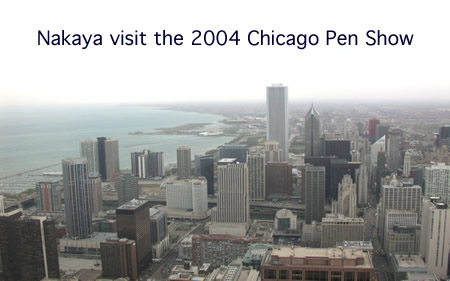
Nakaya pens have been a very popular subject on Pentrace for the last few years
when “discovered” by Pentrace East Editor Russ Stutler when he wrote
a report of
a small company that was created or the purpose of hiring retired craftsmen from
the Platinum Pen Co. Mr. Nakata is Vice President of Platinum Pen Company, formed
by his family in 1919.
Russ had purchased one of their pens and talked about the beauty of his pen
with such enthusiasm we suddenly paid close attention. We saw a new beauty in
a simple and uncomplicated design of a pen without a clip that changes color in
time. Suddenly the Nakaya Wajima tame-nuri became the theme pen of Pentrace.
With Russ’ further reports and articles on Pentrace East we watched
the popularity of Nakaya pens grow and saw remarkable new products being developed.
Some of these products are the new Equilibrium pen with adjustable steel rings
inserted in the barrel to fine tune the balance in the owner’s hand. Other
small details were created to give pleasure to the owner such as the small goldfish
swimming in seaweed, painted on the ink converter and the owner’s personal
Kanji painted in gold or silver maki-e on the pen barrel.
Mr. Nakata has often stated that his major concern is to be sure that the
customer is always satisfied. He personally reviews every order that is received
and replies to every e-mail or letter and maintains contact with the customer
to be sure they are satisfied with their new pen. It is also taken as a personal
responsibility by every employee to create a custom fountain pen to the exact
requirement of the owner. Mr. Nakata has told me he has no plans to build a large
dealer network as he wishes to maintain his responsibility to pay close attention
to every pen order and customer that calls to Nakaya.
Orders for Nakaya pens are now arriving from many countries and the majority
are from the United States. Mr. Nakata decided he would like to visit America
to thank his customers and meet the many people that had corresponded with him.
He related to me one of his main concerns was to see his customers and be sure
they were happy with the performance of Nakaya pens. He also had a great desire
to meet John Mottishaw, the famous nib craftsmen who would share knowledge with
him about creating nibs for American customers. He has a great concern to perfect
the making of stub nibs, and in this manner he would learn to provide a full range
of nibs for his customers.
Mr. Nakata told me in early February he would come to the Chicago Pen Show
in April. We believed that Chicago would give him a good opportunity to meet as
many Nakaya customers as possible. From that day on I was in almost daily correspondence
with Mr. Nakata and others to make arrangements for this visit and be sure that
no detail was overlooked. From the very size of the exhibit space and table size
to determine exact displays to the actual electrical plug to be sure it would
fit. Mr. Nakata decided to bring his master nib craftsman Mr. Watanabe in order
to demonstrate his skill at adjusting and shaping nibs, and Mr. Matsubara would
demonstrate his skill of producing pen caps and barrels from raw ebonite rod stock
in front of the customers. This was going to be a major event for them, as they
never take vacations and always enjoy their work. To visit Chicago and work made
them feel like super stars, which would happen sooner than they thought. Also
attending was Ms. Noritsuke, Nakaya business manager.
A few weeks before the Chicago Pen Show a 208kg (500 pound) crate arrived
at my home. This was the vintage electric and foot-powered lathe machine mounted
on a large cabinet that was used by Mr. Matsubara. This was sent for my care to
be sure it was delivered to the show at the right time and not lost. This lathe
is the very life of Mt. Matsubara, so I had to be very careful with this. Well,
500 pounds is pretty hefty so I knew this would be safe in my garage, it was not
going to move anywhere. A few days later I received four more large cartons of
hand tools and equipment for the show, including many of the pens for the display.
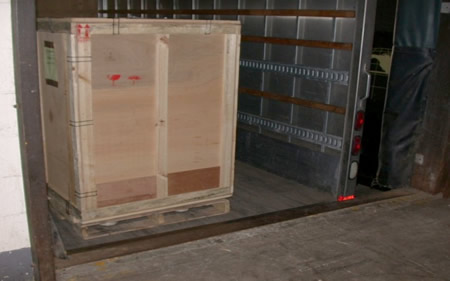
Mr. Nakata and his associates wanted to arrive on Tuesday before the weekend
show. In typical style of preparing for very single detail his purpose was to
study every area of the hotel where he would display so he could present Nakaya
attractively and be able to meet many visitors at one time. On Tuesday morning
I drove to the hotel with the four large boxes and unloaded them at the dock..
At that moment Mr. Nakata called me on my cell phone that he had just arrived
in the lobby. Not leaving the priceless cartons out of my sight for a moment I
had them loaded onto a cart and brought them to the lobby where I met Mr. Nakata,
Mr. Watanabe and Mr. Matsubara.
Now I am a Chicago boy almost my whole life and I speak Chi-caw-ga. With the
help of Russ Stutler and my very dog-eared Japanese Culture Shock book I was able,
I think, to express my self in Japanese trying to hide my distinct Chi-caw-ga
accent. For weeks I was greeting my wife and friends in Japanese. I memorized
many expressions such as domo arigato, konnichiwa and expressions for different
occasions. I was kind of proud of my self, just maybe I would not humiliate myself
by saying something stupid like “my Nakaya pen smells like a fish.”
I had anticipated this moment for a long time and as we greeted….I went
totally blank. I laughed at myself, pictured Will Thorpe and asked myself…what
would Will do…so I just gave my handsomest smile and gave a big Chicago-style
“Howdy!”
After I remembered my Japanese greetings I realized it was very easy to speak
with Mr. Nakata. Although Mr. Watanabe and Matsubara did not speak English, they
just seemed to understand exactly what we were talking about. I made sure everyone
was registered correctly and had the cartons piled into Mr. Nakata’s room
so he could see everything was intact, one less detail to worry about. I could
see that they had a very long trip and a few hidden yawns told me to make this
day short so they could get a good rest for tomorrow. Mr. Nakata somehow received
a jolt of new energy and asked to see every part of the hotel where activities
would be held. Mr. Watanabe and Matsubara are both over 80 years old and they
were smiling in anticipation and anxious to look around. Still, I would make this
a quick tour to satisfy them so they have time to rest. I showed them the smaller
ballroom for Friday and they were very impressed with the large size. This is
enormous compared to some Japanese shows or pen meetings. I showed them the large
ballroom which is about 50’ x 100’ and they were totally amazed. I
showed them the theatre auditorium where the auction will take place and they
were very impressed to see this.
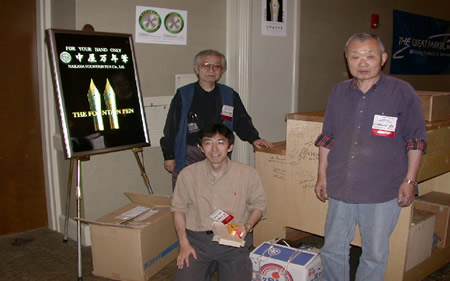
Wednesday morning I arranged for a truck with a lift gate to pick up the 500
pound crate and deliver to the hotel. I anticipated almost any problem and just
in case I put some extra tools, crowbar, plug adapters and several long extension
cords in my car trunk.. As fate would have it, we could not unload at ground level
and the back of the truck was too low for the dock.. Of course, hotels do not
have crowbars or people that lift crates from trucks. I managed to open the scientifically
sealed crate and lift the lathe up to the dock. We wheeled it to a secure area
and I plastered huge signs on every side of the lathe and open crate DO NOT MOVE.
Immediately Mr. Matsubara plugged the lathe into the wall to be sure it would
work. I heard the motor start and I breathed a huge sigh of relief. The crate
was shipped to Chicago by air freight, and would return by ship cargo, it was
critical this specially fitted crate be saved.
After tucking everything safely away the Nakaya team was anxious to see Chicago
so we drove downtown. It was a bright sunny day and I gave them a grand tour of
the famous sights. Downtown could be seen from the hotel and as we got closer
all eyes were trying to see everything at once as I explained the landmarks and
famous locations.
We parked near Michigan Ave. and our first stop was 1,000 feet above Michigan
Ave to the top of the Hancock Building and up the fastest elevator in the world
for an 80-mile view of Chicago and four surrounding states. We walked on Michigan
Ave., called the Magnificent Mile because that is exactly what it is. My greatest
pleasure was watching their faces as they tried to see everything at once and
as new visitors to Chicago, the usual pose was looking up!
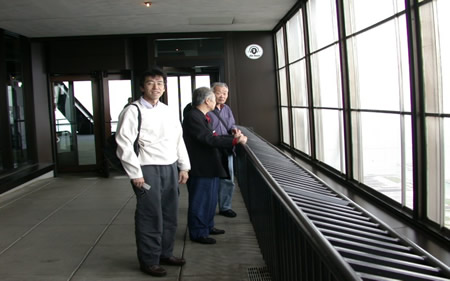
We had dinner at a nice restaurant and returned to the hotel where we started
to meet some early arrivals but called it a night. Time for a good rest before
the big events yet to come.
Thursday morning we again met and I introduced them to early arrival guests
and showed them the Hospitality Suites where early traders were meeting. These
rooms had many tables and traders, actually as big or bigger than any Japanese
pen show. They had a grand time seeing so many people and pens and as I introduced
them the word spread as to who they are and interest was building quickly for
people to visit their exhibit.
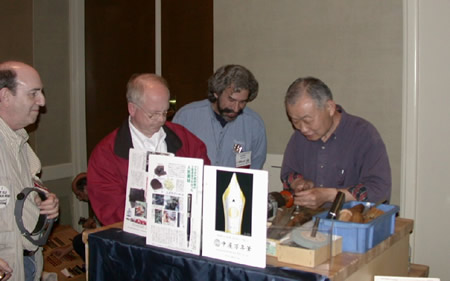
I happen to live about 40 miles from the hotel but I checked in today so I
can be closer to all the action for the weekend. Friday is an early pen trading
day, it is not the main show day and yet attendance was substantial at a few hundred
traders and over 100 tables. Nakaya set up one table to display his pens and immediately
became a major attraction. Mr. Matsubara was working his lathe and Mr. Watanabe
was adjusting and polishing nibs. I suddenly realized that the lathe is made to
operate in Japan at 50 cycles. Here we have 60 cycles. The lathe operated, but
at a much higher speed than Mr. Matsubara is used to. His fingers are very sensitive
in shaping the caps and barrels and cutting threads while operating at various
speeds. He was able to work very well in spite of this higher operating speed
as we could not find a suitable converter. The lathe is incredibly simple and
vintage in appearance. The ebonite rod is simply slipped into what appears to
be a large bamboo or wood collar with split sides. A hard wood ring is pulled
forward to lock the ebonite rod into the tube and the rod spins at a very high
rate of speed. Assorted tools with very aged and worn wood handles and various
shaped cutting blades were used to quickly shape the pens, the ends and also for
cutting the threads. I did not time the procedure but he sure made it look very
easy with 50 years of experience. By Friday evening they had a great taste of
a Chicago Pen Show and they were very happy. They had brought a large quantity
of their most popular tame-nuri pens and they were being purchased very rapidly.
A very impressive display of maki-e pens were also being purchased very quickly.
These are pens shown on their website so customers were familiar with the designs
and models.

Friday night we had a magnificent dinner at a great sea food restaurant. I
have to say that it turned out that I was the one being entertained and this dinner
was a major event from appetizers to dessert. One does not have to decide on an
entrée, just about everything on the menu appeared on the table and every
morsel was consumed.
Saturday is a major trading day, lectures, seminars and the big auction at
4 o’clock.. It was going to be a very busy day. It started with a breakfast
with John Mottishaw who graciously discussed and explained his fine art of producing
stub and italic nibs which were of great interest to Nakaya. John Mottishaw is
a familiar name in Japan, as he has consulted before with other nib masters and
pen makers for many years.
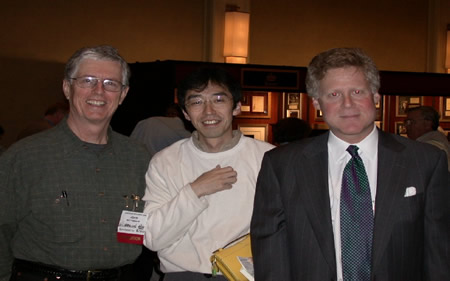
I can say this without exaggeration, from the moment Nakaya was set up in
the show room the crowds never diminished from their tables. One friend of mine
actually told me to call him on his cell phone if I saw that he may be able to
get in and grab a seat. My table was set up right next to them so I had a constant
view of their progress. Lines were actually forming in front of the table with
people waiting to sit in one of three chairs so they can try the full range of
pen nibs and select a pen to purchase. Ms. Noritsuke and Mr. Nakata explained
the order forms to determine the nib styles requested. The customer would chose
a pen from the display and Mr. Watanabe would create their custom nib. The customer
would write with the pens and adjustments would be made until they were satisfied.
At that point Mr. Watanabe would laugh with pleasure that he had created another
happy customer. Mr. Matsubara was turning ebonite caps and barrels all day, the
quiet humming of his lathe told me he was quite busy. The subtle smell of burning
ebonite accented the room. The caps and barrels he was producing were for demonstration
only as they would go back to Japan for maki-e and urushi decoration. As the day
progressed I noticed some customers were returning. Well-known pen dealers were
returning, more than a few pen manufacturers were also returning. Many people
were so pleased with their Nakaya pens they were actually coming back to buy a
second and a third pen. The incredibly beautiful maki-e pens were quickly disappearing
from the table. Crowds were forming on the sides and almost behind Mr. Matsubara.
Mr. Nakata gave visitors a big black Sharpie and asked everyone to autograph Mr.
Matsubara’s cabinet. Many people happily signed their greetings and best
wishes, and he was very proud to have them sign all over the sides. Mr. Nakata
finally admitted that he and Ms Noritsuke were upset for only one reason. They
had greatly underestimated their reception and were almost completely sold out
of pens by Saturday. Most of what was left was purchased on Sunday and many orders
were placed. Orders for custom maki-e pens were also taken. Mr. Nakata brought
a beautiful color catalog of maki-e design from a famous maki-e museum collection
in order to show designs of animals, flowers and various topics. The catalog alone
was outstanding and certainly helped but to me it would only made the decision
even more difficult.
This was a very exciting day, not only for Nakaya, but also for me. I was
very pleased to see their success and especially the many people that told me
how happy they were that Nakaya came to visit. Sunday was a repeat of Saturday
with a constant crowd of people visiting and returning.
Saturday after 4pm Mr. Nakata and Ms Noritsuke left to see some special shops
in Chicago and we planned to meet downtown later after the pen auction. I had
a short dinner with Mr. Watanabe and Matsubara and we walked over to the auction,
which they greatly enjoyed following from the catalog.
Later I took a quick cab ride downtown and met Mr. Nakaya once again, up to
the Hancock Observatory for a night view of the city for Ms Noritsuke. I soon
realized that Mr Nakata is a huge fan of American baseball and football and he
had a stream of questions about our Chicago teams and players. We were only a
block from Mike Ditka’s restaurant, the former coach of the Chicago Bears
so it was a given we would have dinner among Chicago Bear and NFL trophies and
signed footballs lining the walls. Dinner was another grand event, starting with
shooting Cowboy oysters, (from a shot glass with Tabasco sauce trim ) not quite
my favorite thing but got through it and survived. Black sweatshirts with gold
maki-e Mike Ditka trim were the souveniers after dinner, a jump into a waiting
cab and we were off to Buddy Guy’s Legends Blues café where Ms Noritsuke
was promptly carded at the door. The bouncer was very serious when he said she
just did not look over 21. Chicago Rule #1, never argue with a Chicago bouncer.
She was delighted and I told her I really did not plan that one. Up close and
intense Chicago Blues, shooting some pool and Goose Island beer, what a great
combination and let me tell you, I was impressed how they handled the cue stick.
By 11 I could see it was time to head back to the hotel. Another sweeping Chicago
night skyline view cab ride and within a few minutes I could see Mr. Nakata was
out like a light. He had a busy few days and it was finally catching up.
Sunday 8am was another rush into the main show room, everyone was busy setting
up or dropping bags and going shopping to see new “stuff” from newly
arrived dealers and collectors. Nakaya was already set up and plugged in, all
they had to do was spread what pens were left. Stylophiles had borrowed a few
pens for photography and were returned just as customers were standing in line
waiting for early pickings. From 8am to 6pm it was busy, no exaggeration necessary,
this was really a unique event for the Chicago Pen Show and everyone was quite
impressed. Even Nakaya’s importer-shipper attended the show, coming to see
what all the fuss was about a vintage Japanese pen lathe. After he show we made
sure the lathe was carefully crated up again and prepared for shipment.
Mr. Nakata told me this visit was more successful than he imagined. He met
many Nakaya customers and made many new friends. One of his great pleasures was
meeting so many people he has read about in various pen magazines and seen on
the internet. He greatly enjoyed the compliments and admiration from so many people,
which he would carry back to Japan and relate to his friends and other employees
of Nakaya and Platinum Pen Company.
My thanks also go to Russ Stutler for assisting all
of us to plan this memorable visit.
|